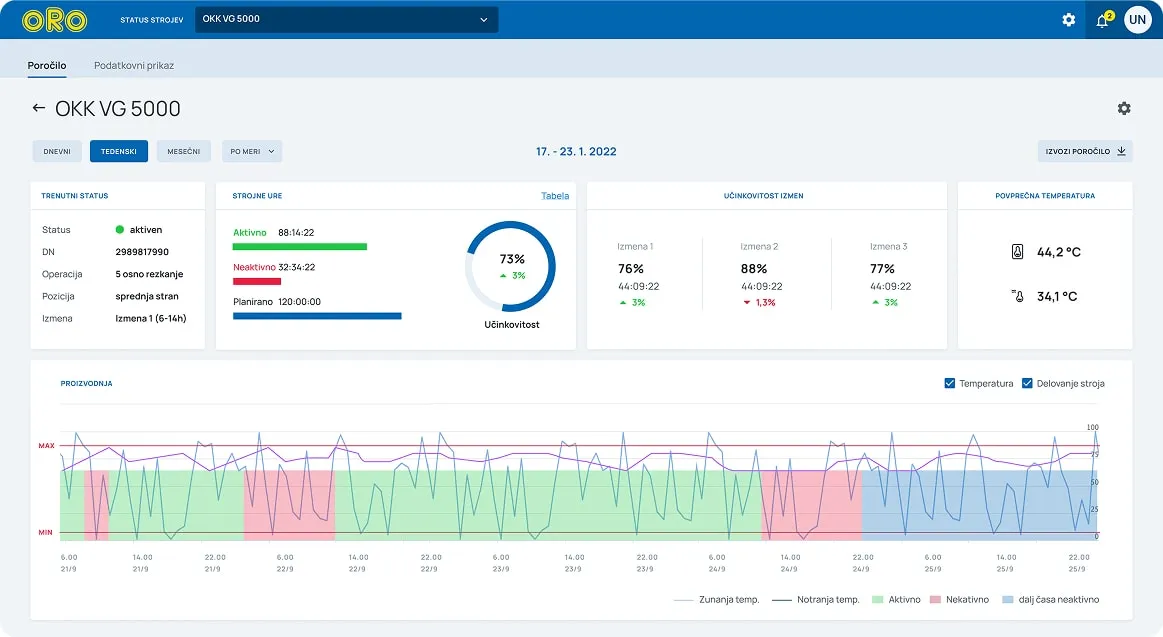
A client approached us with a specific goal: to optimize the efficiency of their CNC machines.
Machine utilization is a critical factor
In the initial phase of our collaboration, it was essential for the client to understand exactly how much time each CNC machine was operational during the plant's scheduled production hours. This insight would serve as a foundation for identifying bottlenecks, reducing downtime, and improving overall productivity.
It was not only the data itself that interested the client, but also how that data was presented. They wanted a clear, real-time overview of each CNC machine—specifically their current status (on/off) and temperature. At any given moment, the client needed to be able to monitor machine conditions easily and efficiently.
To meet this need, we developed a mobile-friendly web interface that provided an intuitive and visually appealing dashboard. Improving machine visibility did significantly enhance efficiency according to their feedback. Their next step was to integrate machine operating times with work orders. This connection offered new insights: by aligning machine usage data with specific work orders, we were able to track exact timings for each production job.
At this stage, the system had evolved into a basic Manufacturing Execution System (MES), capable of tracing work times across each phase of the production process. However, efficiency improvements in productions proved to be less valuable than a surprising new area: scheduling and costing.
Predictions for optimized manufacturing
One of their critical business processes is preparation of offers for clients. Typically, this begins when a client provides a 3D model of the desired end product. From there, a complex and time-consuming engineering process unfolds: Their engineers must transform the 3D model of the final product into a precise 3D model of the final product.
To make this process more efficient, the client decided to start implementing a system which would enable predicting manufacturing times directly from the 3D model of the end product. Since actual production times were already being tracked and connected to specific work orders, we had a critical piece of information—the actual time required to produce a tool.
It was crucial to extract the parameters which strongly correlate with manufacturing complexity and time. These parameters were defined from the tooling models. There are many parameters that affect production time (dimensions, number and complexity of cavities, radius and curvature features, number of drills needed, etc..).
Ultimately, we were able to isolate t 3 parameters - the most influential parameters - those with the greatest impact on tooling design and, ultimately, on CNC machining time. The key parameters were:
- The overall dimensions of the tool.
- The volume of material to be milled from the surface.
- The number of cavities, adjusted by a radius complexity factor.
We tested a large number of parameters before settling on just these 3 critical values– that meant evolving into a fairly advanced MES system. With other clients, we learned how to do this isolation with less product building
Extracting these parameters from the tooling model and correlating them with manufacturing times has enabled us to predict production durations once the tooling model is created. This process was not straightforward and required many iterations and adjustments to achieve accurate approximations.
While the 3D models provided by customers are generally basic and lack sufficient detail to automatically generate complete manufacturing design they do offer enough information for comparison. At this stage, we had the ability to compare the new orders with the existing. An interface was created where the salesperson can view a list of similar products and identify the model that most closely correlates with one that has already been produced in the past.
So now they had the ability to predict the manufacturing times, based on the model provided by the customer. This prediction was far faster and involved far fewer people.With this in place, the client is able to bid on more fast turn-around projects and spend more of their bid teams energy on optimizing risks and scheduling.
For us, the big learning was that efficiency is not the only significant benefit from tracking data. Also, it was a great lesson in actionable data vs all the data that can be collected.
By Borut Terpinc